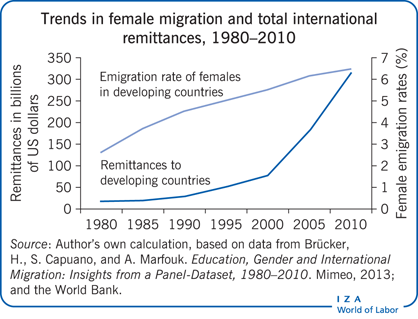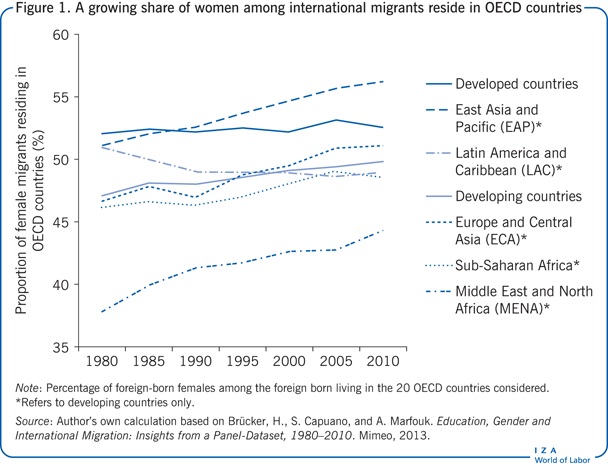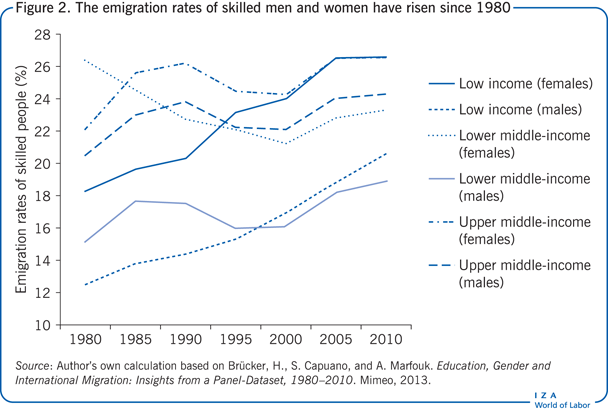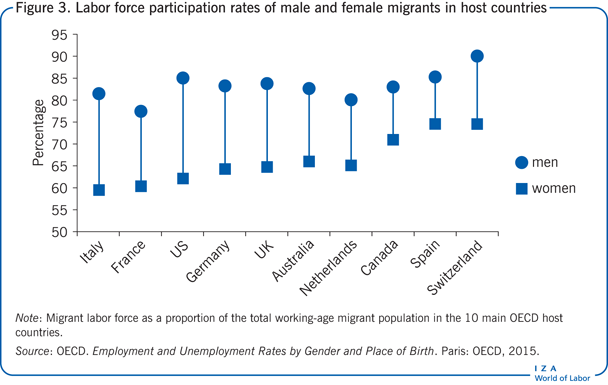Elevator pitch
Migrants’ remittances to developing countries have increased in recent decades, partly due to reduced transactions costs and improved living conditions in host countries. The feminization of international migration represents yet another explanation. Despite the difficulties female migrants encounter in the labor market, their total remittances may be higher and more resilient than those of male migrants, owing to these women’s stronger links to family members left behind and self-insurance motives. Policymakers need to understand how this new and significant upward trend in female migration could affect the economic and social development of home countries.

Key findings
Pros
Women are increasingly moving independently in search of better jobs, leaving family members behind and generating remittances.
Female migrants tend to stay linked to and sacrifice more for the family back home, thus adding to the reliability of their remittances.
Female migrants face uncertainty and risk in destination labor markets; this may encourage them to remit to self-insure against possible negative shocks.
The rising emigration rate of skilled women may have a positive impact on remittances due to higher earnings.
Cons
The “double disadvantage” of being an immigrant and female could negatively affect job quality and earnings in the host country.
Many female migrants are employed in domestic jobs and hold temporary work contracts; the low wages they earn abroad and their limited access to property rights back home means their future return plans are associated with fewer remittances.
Many women continue to migrate to join their families, especially in developed countries, leaving behind fewer close relatives.
Women’s professional outcomes tend to be negatively affected when they migrate with their husbands.
Author's main message
Female migrants’ remittances are smaller than those of male migrants because they face multiple difficulties in host-country labor markets. Nevertheless, at the macroeconomic level, the higher share of female migrants seems to be associated with more remittances received by home countries. Female migrants are more likely to send money home than male migrants. Further, their remittances are more resilient and reliable and, thus, potentially useful to poverty reduction in recipient countries. Policymakers should recognize the importance of female migration in the remittance–development nexus by addressing the labor market difficulties female migrants face.
Motivation
Female migration from some parts of the world—mainly for family reunification—has been slowly increasing in recent years. But women are also moving on their own and searching for work to provide for their families back home. As a result, these autonomous female migrants are becoming significant contributors to remittances and thus are contributing to the economic development of their home countries.
Gender is correlated with many of the main determinants of remittances, such as the difficulties migrants face in host-country labor markets, their legal status, and the strength of their ties to relatives at home. The feminization of international migration flows can therefore have significant effects on the volume of remittances received by developing countries. Although the effect of remittances on economic growth is ambiguous, evidence shows that they have in general a poverty-reducing effect. While most studies on the remitting behavior of international migrants are gender-neutral, some researchers have begun to examine the role of gender in shaping the pattern of remittances.
Discussion of pros and cons
Feminization of migration and trends in remittances
Migrant remittances to developing countries have been increasing since 1980
Remittances to developing economies have significantly grown over the past three decades, except during the 2008 financial and economic crisis. According to the World Bank, formal remittance flows to developing countries grew by 4.4% in 2014, reaching $436 billion. They are expected to reach $440 billion in 2015. Among developing regions, the main recipients are East Asia and the Pacific region (37%), closely followed by South Asia (26%). Officially recorded remittances exceed official development assistance in all developing regions except sub-Saharan Africa and are said to be more stable than other external financial sources of development.
The increase in the stock of migrants worldwide and improvements in their standards of living at destination explain some of the significant increase in remittances to developing countries. The contribution of these two factors to the substantial rise in remittances to developing countries between 1990 and 2010 is estimated at 21%. The remaining share of remittance increase is attributed to a change in the way of measuring remittances. However, if we assume that remittance behavior differs between female and male migrants, then changes in the composition of international migration may be another explanation for the growth in remittances.
Trends in female migration differ across countries
According to the UN, the stock of international migrants accounted for 3.2% of the world’s population in 2013. Among these international migrants, approximately 48% were women. While female migrants outnumbered their male counterparts in more developed countries (51.6%), partly due to family reunification policies and better work opportunities in some of these countries, they remained underrepresented in less developed ones (43.0%). At the regional level, female migrants were the most numerous in Europe, both in absolute terms (72.5 million) and as a share of international migrants (51.9%). The share of women among international migrants was the lowest in Asia and in Africa, where the proportion fell respectively from 45.6% to 41.6% and from 46.6% to 45.9% over the period 1990–2013.
Figure 1 shows that while female migrants have outnumbered their male counterparts in developed countries since 1980 (a phenomenon that has been driven by female migration from developing countries), the share of female migrants residing in OECD countries has risen only slightly. Indeed, in the 20 OECD countries under review, the share of female migrants to total migrants from developing countries increased from 47.1%, in 1980, to 49.8%, in 2010. At the same time, the share of female migrants who moved from one developed country to another more or less stagnated. Among developing regions, we observe a substantial increase in the share of women among international migrants from the Middle East and North Africa (MENA). However, the number of female international migrants exceeded that of men only in the East Asia and Pacific region (EAP) (for example, Thailand and the Philippines) and East and Central Asia (ECA) (for example, Turkmenistan, Belarus, and Kyrgyzstan). Most countries whose female migrants living in OECD countries outnumbered their male counterparts belong to these two regions.

Female emigration rates are obtained by dividing the stock of migrant women from a country by the number of women in the total population (including migrants). Figure 2 shows that, between 1980 and 2010, the number of female migrants increased in most income groups, except for lower middle-income females. The rate was especially high for upper middle-income females, where the emigration rate more than doubled, reaching almost 26% in 2010. Although not shown in the figure, more detailed data (from the same source) shows that, after the many small islands of the Pacific and the Caribbean (Tonga, Samoa, Dominica, Grenada, etc.), developing countries with the highest female emigration rates, in 2010, were El Salvador (24%), Bosnia and Herzegovina (18%), Albania (16%), and Mexico (12%), four countries which also have high total emigration rates.

Figure 2 shows that the increasing emigration rates of skilled men and women from developing countries, since 1980, resulted in an increasing brain drain. It also shows that more skilled females emigrated than skilled males. This increase was particularly pronounced in low-income countries.
Female economic migration has increased in recent years
Figure 3 shows labor force participation (LFP) rates for male and female migrants in some OECD host countries. Despite an increase in the female migrant LFP rate, the rate for male migrants was still higher. According to OECD data, in 2013, the migrant LFP rate in OECD countries was 65% for women on average, compared to 82% for men. The female migrant LFP rate was especially low in Italy, France, and the US. In addition, the gap in the rate between males and females was higher among migrants than among natives. The relatively low LFP rate for female migrants suggests that, for some countries, a large proportion of female migrants moved for family rather than economic reasons. Although this is not shown in the figure, the evidence from Eurostat data for 17 EU countries confirms this assertion: in 2008, more than twice as many females than males migrated to EU countries for family reasons. However, OECD data indicate a slight increase in the LFP rate of female migrants in OECD countries between 2001 and 2013. This trend could be due to an increasing number of female migrants entering the labor market or a growing number of women who migrate, on their own, in search of opportunities.

Women’s independent migration may not have the same consequences on remittances as men’s migration because women’s migration generally involves leaving parents or children behind. Indeed, beyond the increasing share of women among migrants from developing countries, there has been a significant change in women’s motives for sending remittances home. Although women mainly continue to migrate as dependents of their spouses or to marry, more and more women are likely to be autonomous economic migrants who financially support husbands, children, or other family members left behind. Evidence shows that female migrants account for a majority and/or a growing share of labor migrants for some developing countries (Sri Lanka, Indonesia, Peru, Cape Verde, Philippines [1], Bangladesh, Thailand, Ethiopia, etc.), or in some specific corridors (from Latin America to Spain or Italy; from Eastern Europe to Italy, etc.).
The growing demand for low-skilled services in developed and aging economies and the persistent poverty and high unemployment in developing countries explain the recent increasing share of women among the international migrants who move from developing to OECD countries in search of work. The South–South economic migration of females is also an important factor. For example, many women from poor Asian countries migrate to rich Asian countries (Singapore, Taiwan, Hong-Kong, Malaysia, etc.) or to Gulf states (Kuwait, Saudi Arabia, United Arab Emirates, etc.). Improvements in living standards and the rising participation of women in the labor market in these destination countries explain the increasing demand for female migrants to do domestic work there. The literature also mentions the “surplus of women” as a possible explanatory factor for the economic migration of women from the former Soviet Union.
The “double disadvantage” of being female and a migrant
International migrants, particularly those from developing countries, are more likely to be relegated to precarious, low-paying positions, are concentrated in low-skill jobs, and are more affected by unemployment than natives. This observation has been made in many OECD countries, such as France and Spain, and in the EU more generally. According to the OECD, the average unemployment rate among foreign-born migrants living in OECD countries in 2013 was 13%, while for natives it was 9%. The obstacles migrants face in host-country labor markets are mainly linked to the lack of recognition of their diplomas they acquired in their country of origin, their limited command of the language of the host country, but also discrimination. Female migrants incur even more pronounced discrimination at work than men because they may suffer from the “double disadvantage” of being both migrants and women (even if the migrant dimension seems to have a greater impact than gender).
If we look at recent unemployment rates, the disadvantages female migrants face are not striking when compared to male migrants. In 2013, the unemployment rate of female immigrants living in OECD countries was 14%, compared to 13% for male migrants. This shows that all migrants faced employment difficulties in almost equal measure. Moreover, although the unemployment gap was particularly wide in some countries, the difference in the unemployment rate between foreign-born migrants and natives in OECD countries was, on average, only slightly higher among women than among men (five percentage points for women against four percentage points for men).
Beyond unemployment, other work-related factors add to the disadvantages female migrants face. Working conditions and job quality appear to be particularly precarious for female migrants. These women are more likely to work in temporary, part-time, low-skilled jobs than natives and male migrants. For example, international female migrants from developing economies are overrepresented in the hospitality industry (in hotels and restaurants) or among caregivers and domestic workers. Domestic work is the largest source of employment for foreign women, especially in Asia. In addition, at equal levels of education, foreign-born women tend to hold fewer skilled jobs than native-born women. Further, skilled female migrants are more likely than skilled male migrants to end up in jobs that do not correspond to their education level and qualifications in what is referred to as “brain waste.” Moreover, the joint migration of husbands and wives has been shown to negatively affect women migrants’ professional outcomes.
Finally, for female migrants, the precarious nature of work in host countries is often associated with an unregulated or at least unstable legal status. For example, a large proportion of female migrants working in the domestic sector are undocumented and do not benefit from protections accorded under labor legislation.
What we know about female migration and its impact on remittances
Despite the significant changes in the composition of international migrants, little attention has been devoted to the effect of these changes on home countries, in particular, as they relate to remittances. The gender dimension may affect the main determinants of remittances. Gender influences migrants’ capacity to send money home, their network (parents or children left behind), their legal status, the strength of their ties with their home country, and their willingness to return there, etc. This is why the feminization of international migration may explain this group’s propensity to remit and the amounts remitted. Gender may also partly explain the upward trend in remittances over the past two decades.
Gender has an impact on the propensity to remit and the amount remitted
The growing number of women migrating from developing countries means these countries are losing valuable human capital. This can have a direct effect on these countries’ economic and social development. Remittances also have an effect on development, though indirectly. However, the difficulties female migrants face, in host countries, impede their ability to send money home.
Evidence shows that women are likely to send less money home than male migrants. For example, Filipino overseas workers tend to remit significantly more than their female counterparts. Similar results were found in the case of Vietnamese [2] or Moroccan migrants [3]. Among migrants living in Germany, female migrants also tend to remit less than male migrants, except among those who had acquired German citizenship, where no significant difference was found [4]. This is at least partly because of income disparities and the greater obstacles that women encounter in the labor market [5].
Female migrants tend to hold temporary work contracts, which makes their outlook for long-term work uncertain and increases their likelihood of returning home. Plans to return home in the future may have a positive effect on their remittances, but they could also be associated with fewer remittances. This is particularly so for female migrants from developing countries, where their access to property rights at home is limited because of legal or cultural constraints, meaning they have less motivation to invest in their home country [4]. When women migrate for family reasons, they tend to move permanently and are less likely to leave close relatives behind. This factor could have a negative effect on the size and frequency of remittances. Nevertheless, given the strength of the links they maintain with their families, some female migrants tend to have a higher propensity to remit, for example, in the case of internal migrants in Thailand [6] or Mexican migrants living in Houston, Texas [7].
The evidence at the aggregate level points to a positive correlation between female migrants and remittances. However, because the country-level data on remittances (as a component of the balance of payments) is not broken down by gender, it is difficult to estimate the impact of the growing feminization of international migration on the amount of remittances developing countries receive. In a recent paper, new data were used that show international migration and include remittances from 89 remittance-sending countries to 46 remittance-recipient ones, over the period 1985−2005. The objective was to investigate whether changes in the gender and education level of international migrants affect the amount of remittances [8]. Results point to a positive correlation between the share of female migrants and the amount of remittances home countries received. The correlation is even stronger in the case of college-educated women. Similarly, in the case of migrants living in Germany, women with higher education tend to remit more money, but—in contrast to the other study—the educational level does not influence the remitting behavior of their male counterparts in this case [4]. However, the potential effect of the feminization of migration on the volume of remittances received by developing countries remains ambiguous: while females tend to remit smaller amounts, mainly because of their lower earnings, they often have a greater propensity to remit than men. This greater willingness to remit may be related to differences in their underlying motives for remitting.
Does gender have an impact on the resilience of remittances?
Remittances have a stabilizing effect on recipient economies. They often act as an informal insurance mechanism because they provide recipients with the necessary funds to respond to negative shocks that affect their households (such as natural disasters, job loss, or illness. By acting as a buffer against economic risk and due to their stability over time, remittances allow for the smoothing of recipient household consumption and contribute to poverty reduction. The role remittances play in providing financial resilience and insurance largely depends on the underlying motives for remitting, which may differ between female and male migrants. The motives for remitting can be classified into three broad categories: “pure altruism” (the utility of the migrant grows with the consumption of his/her family left behind), “pure self-interest” (investment or inheritance objectives), or a combination of the two, known as “tempered altruism” or “enlightened self-interest” (loan repayments to the family or an informal co-insurance agreement between the migrant and his/her family) [9]. While the motives for sending remittances are understood, we need to know more about whether resilience of remittances varies with the gender of international migrants.
Evidence shows that while female migrant workers are disadvantaged in the workforce and on average earn less than male migrant workers, they tend to maintain closer links with their relatives, behave more altruistically, and have a greater sense of sacrifice and duty towards their families at home. This behavior is often a reflection of cultural norms and traditional gender roles [1], [10]. Consequently, in some cases female migrants are found to remit a higher share of their earnings more frequently than male migrants. Thus, remittances from female migrants may represent a more reliable source of financial support for recipient households. This disparity between females and males would cause parents in some countries to favor the migration of their daughters over that of their sons [1].
There are several examples of female migrants with strong attachments to relatives back home. Vietnamese female migrants seem to visit their families more frequently than their male counterparts [2]. For female Mexican migrants, changes in income seem to have less effect on remittances. This is consistent with the altruistic remitting behavior of female migrants [7]. Moreover, in the case of migrants from Thailand, the assimilation of traditional gender roles, transmitted by Buddhism (daughters are expected to financially support their parents), explains why remittances from Thai females are more reliable than those from Thai males [10]. Hence, despite the smaller average monthly income Thai female migrants earn, this group sends, on average, a slightly higher monthly amount of remittances and a higher value of goods per month than male migrants. Further, remittances from Thai female migrants exhibit more altruistic patterns compared to those of Thai male migrants [6].
The altruistic behavior of female migrants could explain why their remittances are more reliable than remittances from male migrants. However, co-insurance considerations are also a factor as these seem to differ according to the migrant’s gender. Evidence shows that remittances from female migrants from the Dominican Republic living in the US seem to respond significantly to negative economic shocks affecting their parents left behind (insurance motive). However, except for males who are the only migrant from the household, male migrants from the Dominican Republic do not generally remit to cover a family emergency [11]. The particularly unstable and risky situation female migrants face may provide them with more incentives to maintain strong ties with their relatives at home and to use remittances to self-insure against negative shocks. This was found in the case of Mexican migrants of both sexes who had become established in the US [12]. In a study on migrants from the Philippines, it is shown that single female migrants remit more than their male counterparts to respond to their duty towards their families and to secure their futures.
Limitations and gaps
Migrants’ gender influences the underlying motives to migrate and remit, and the frequency and amounts of remittances. Migrants’ gender may also significantly shape the impact of remittances on economic development. However, research is limited in terms of gender and the development outcomes of remittances. Consequently, it is difficult to predict the possible influence of the feminization of international migration flows on remittances, and their correlation with economic growth and poverty reduction.
While female labor migration may have a positive influence on remittances to home countries in some cases, the emigration of skilled women means home countries lose valuable human capital. For policymakers to understand the impact of female migration on the development of receiving countries, more data is needed on female migrants, their remitting behavior, and their skill levels in developing countries, in particular, where 80% of female migrants reside. This information would provide the necessary background for good policy design.
Summary and policy advice
Gender affects remittances mostly through the conditions migrants encounter in host labor markets and the strength of their ties to family back home. While studies on the feminization of migrants and remittances are inconclusive and depend on the corridor (that connects migrant sending and receiving countries) examined, at the global level female migration seems to be positively correlated with the remittances developing countries receive. Female migrants’ remittances are more resilient and reliable than those from male migrants. The altruistic behavior of women, their duty towards their families, and the self-insurance motives encouraged by their precarious situations in host country labor markets explain this phenomenon.
The potential positive effects of female migrants’ remittances on poverty reduction in home countries pose challenges for policymakers. More relevant and detailed gender-based information would help them design policies to reduce the barriers female migrants face in terms of employment, wages, and remittance costs. Improved working conditions for migrant women (long-term contracts, better-paying jobs, better job matches) and lower bank charges would enable them to remit larger amounts of money more often.
Acknowledgments
The author thanks an anonymous referee and the IZA World of Labor editors for many helpful suggestions on earlier drafts. Previous work of the author (together with Sara Salomone) contains a larger number of background references for the material presented here and has been used intensively in all major parts of this article [8].
Competing interests
The IZA World of Labor project is committed to the IZA Guiding Principles of Research Integrity. The author declares to have observed these principles.
© Maelan Le Goff